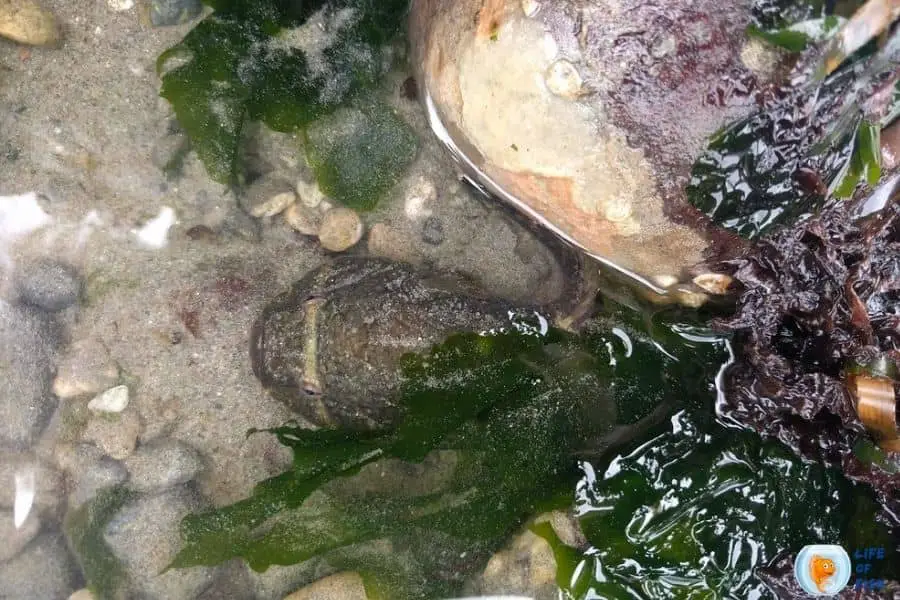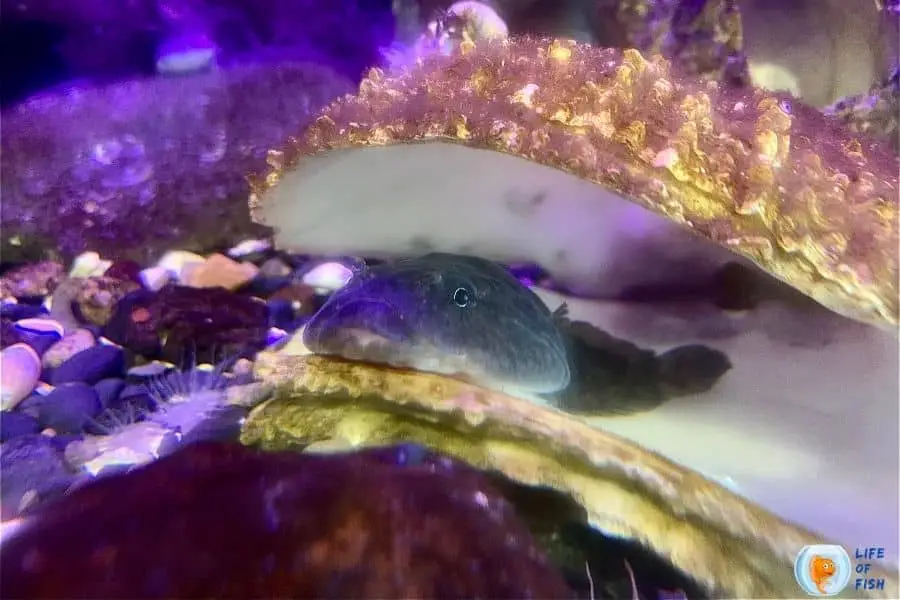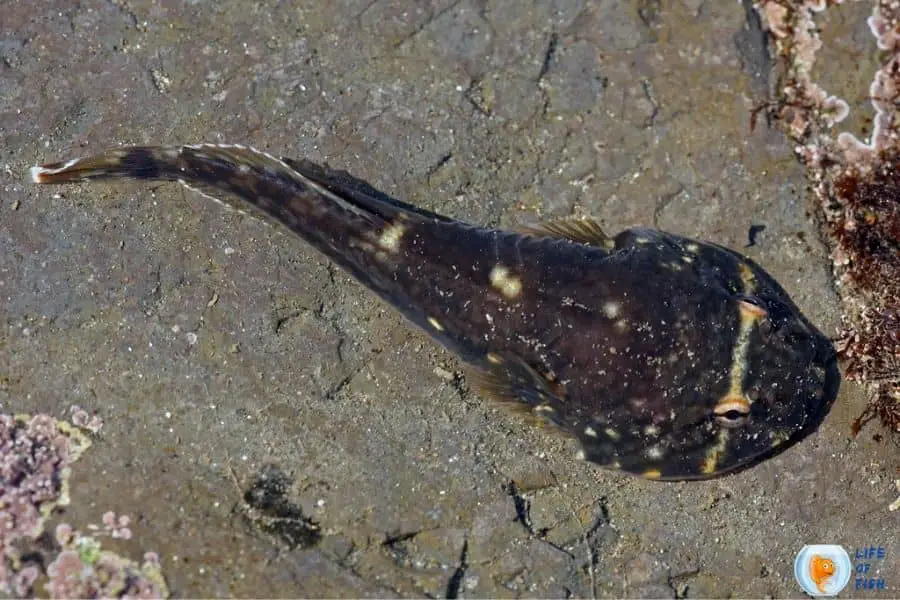The northern clingfish is a species of saltwater fish. It is native to the Pacific coast of North America from Revillagigedo Island and Baja California north to Southeastern Alaska.
They have unusual shapes and are not pleasant to see!! The Northern clingfish are shaped like tadpoles with a wide flattened head.
Further, they don’t have scales and are covered with a thick coating of slime. The slime makes them very slippery.

The main distinguishing icon of this fish is a large suction disc formed by the union of the pelvic fins and adjacent folds of flesh.
This special disc allows the fish to attach to a substrate like a sea bottom or rocks. They can remain on the surface they attach in this way without flushing away with the ocean waves.
They have only one dorsal fin and have no spines in their body.
The Northern clingfish can be brown, gray, green, or a dark red color. It has a distinct chain-like pattern or “reticulations’ ‘.
A basic identifying feature of this species is a white stripe that appears to connect the two eyes. You can see more of these stripes in younger Northern Clingfish but are confined to one stripe when they become mature.
They are members of the clingfish family as their name suggests. The cling fish family is scientifically known as the family Gobiesocidae.
Northern clingfish is a member of the order Gobiesociformes. The scientific name of the Northern clingfish is Gobiesox maeandricus. It is categorized in LC, the Least concern category in IUCN.
One look guide
Jump To
- 1 One look guide
- 2 Where do they form?
- 3 Northern clingfish behavior
- 4 Northern clingfish lifespan
- 5 Northern clingfish weight
- 6 Northern clingfish length
- 7 What do northern clingfish eat?
- 8 How do Clingfish Digest shells?
- 9 How does a Clingfish cling tightly to rocks?
- 10 Can you keep northern clingfish in an aquarium?
- 11 Are northern clingfish protected?
- 12 Reproduction
| Scientific name | Gobiesox maeandricus |
| Common name | Northern clingfish |
| Care level | Difficult |
| Native to | Pacific coast of North America from Revillagigedo Island and Baja California north to Southeastern Alaska. |
| Type | Saltwater fish |
| Color | Varies ( Brown, gray, green, or a dark red color ) |
| Prefered temperature | 17.5 to 29.0ºC (average 23.0ºC) |
| Prefered salinity | 30-35 ppt |
| Growth rate | Unknown |
| Prefered food | Smaller Northern Clingfish Small crustaceans Isopods mollusks Adults: Limpets |
| breeding | Egg laying species |
Where do they form?
As mentioned earlier, they form on the Pacific coast of North America. They have got their name “Northern “ because of their native place.
They spread excessively in Revillagigedo Island, southeastern Alaska to southern California, USA; also off Baja California, Mexico.
They can be found in intertidal rocky areas among algae, and on kelp (often high in the kelp canopy). They can even stay out of water under rocks or seaweeds. The clingfish is usually found among species of fish including gunnels, and sculpins.
They live in 0-8m water depth.
Northern clingfish behavior
As their name implies, this fish spends most of its time clinging to a substrate such as rocks, and the ocean bottom.
They don’t flush away with the ocean waves due to the strong action of the suction cup. They usually, wag their paddle-shaped tails while clinging to rocks.
Further, their suction cup helps them to make nests for their eggs. They leave the substrate just for looking for foods and their mating season.
They are semi-aggressive and territorial. However, in an aquarium, they live peacefully with most of the fish species.
They become more territorial when they live with the same species or other clingfish species in one aquarium.
The Northern clingfish are nocturnal and they leave their clinging surface at night to hunt for their meals. They are carnivores.
In their natural habitat, the intertidal zone, Northern Clingfish are susceptible to air exposure and desiccation.
They have specially developed modifications to survive during low tide. It is their pectoral fins and it helps to keep water close to their gills for respiration.
Therefore, they can breathe even when not submerged in water. Further, if they are exposed to air, they can breath breathe through their gills for a short period of time.
The Northern clingfish do not interact with other species, other than to feed. During low tide conditions, they also serve as a food source for raccoons, snakes, etc

Northern clingfish lifespan
The exact lifespan of the Northern clingfish is still not determined.
However, the other members in the clingfish family live 5-10 years and we can roughly estimate the lifespan of the Northern clingfish also between these numbers.
Northern clingfish weight
The exact body weight of these fish is not known. They are small fish and weigh only a few grams.
Northern clingfish length
Most of the species of clingfish are small, except the South African species.
Generally, Northern clingfish are 3 inches (76 cm) in length and can grow up to 6 inches (15.2 cm). The males of this species are larger than the females.
What do northern clingfish eat?
The Northern clingfish is a predatory species. its diet changes based on its size. The smaller Northern Clingfish feeds on small crustaceans, isopods, and mollusks.
The larger clingfish are heavily fed on limpets attached to the surrounding rocks. Actually, limpets are also strong and you may have experienced that it is tough to pull them off a rock.
The secret of grabbing them is stopping them from creating suction in the first place.
Therefore, the clingfish closely monitors the movement of its targeted limpet and at the point, it is about to move the clingfish leaps forward and upward, dives onto the shell with its mouth open, and grabs it quickly.
The Northern clingfish has distinct morphologies that help it obtain its food.
While they are searching for food in nearby rocks, the adhesive disk on the underside of their bodies helps to stabilize the fish.
The mouth of a clingfish is located towards the front of its flattened head. Its mouth contains chisel-like teeth that are used to grab its food.
The combination of the adhesive disk, mouth and teeth helps them to pry food off of the rock while keeping their stability unchanged.
The clingfish is an aggressive feeder and in artificial habitat will quickly take food or bite your finger!!. Northern clingfish are considered cannibals as they eat their own kind.

How do Clingfish Digest shells?
Actually, they do not digest shells. Instead, they eliminate the hard parts of the limpets; shells as a whole are encased in mucous capsules.
How does a Clingfish cling tightly to rocks?
The finger-sized Northern clingfish employs one of the best suction cups in the world.
A small disk on its belly can attach to wet, slimy, even rough surfaces. The adhesive force of the clingfish was 80 to 230 times the body weight of the fish.
Scientists proved that the adhesive force of the suction cup of these creatures works even after their death!!
According to the researchers, dead fish could still suction with 96 percent the tenacity of live fish.
The suction cup or the disc is located on the belly of the clingfish. The rim of this disc is covered with layers of micro-sized, hairlike structures.
These hair-like structures are not the same size but are in different sizes. The layers of these structures create more friction along the rim which helps them to cling to different species.
On closer inspection, the researchers determined there were two forces working together to keep the fish’s grip discs in place.
They are adhesion and friction. Adhesion creates an area of low pressure between the rock and the disc. it seals the clingfish to the surface.
The force of the friction prevents that disc from sliding around. Actually, the secret behind their high suction power lies in the surrounding hairlike structures which were described before.
These tiny, different-sized hairs increase the surface area of the disc. It in turn increases friction and keeps the suction sealed tight.
Can you keep northern clingfish in an aquarium?
Yes, they can be kept in aquariums. It is common to find it as part of larger aquariums and it is regularly sold in certain pet stores.
However, you should have special arrangements to keep them in the aquarium because of their dietary needs.

Are northern clingfish protected?
They are not included in the Red Data book and are not currently threatened or endangered.
They are very common to see in their native places. However, conservation efforts are already in place that will indirectly help protect the Northern Clingfish.
The natural habitats of Northern clingfish are rocky shores and they are at risk from coastal development and pollution such as oil spills and agricultural runoff.
Strong efforts have been made to reduce the pollution in many of the communities they inhabit.
Further, careless visitors can trample tide pool animals such as clingfish underfoot. Some visitors may collect sea stars or other souvenirs to take home, which can leave tide pools barren of life.
Therefore, the local authorities should take necessary actions to prevent such activities.
Reproduction
Usually, Northern clingfish reproduce in the spring. Before reproduction, males build nests in their territories out of rocks in the surrounding area.
The females lay large amounts of eggs and the males release their sperm on them to fertilize them. The males stay close to the nest to guard the eggs until they hatch.
The planktonic larvae swim in the open water and soon are large enough to latch on to the kelp with their developing adhesive disk. They develop until they have reached their full size and join their adults.
No significant migrational patterns have been found within this species.
Read Next : Rhinopias Frondosa | The Vicious Scorpion Fish |
